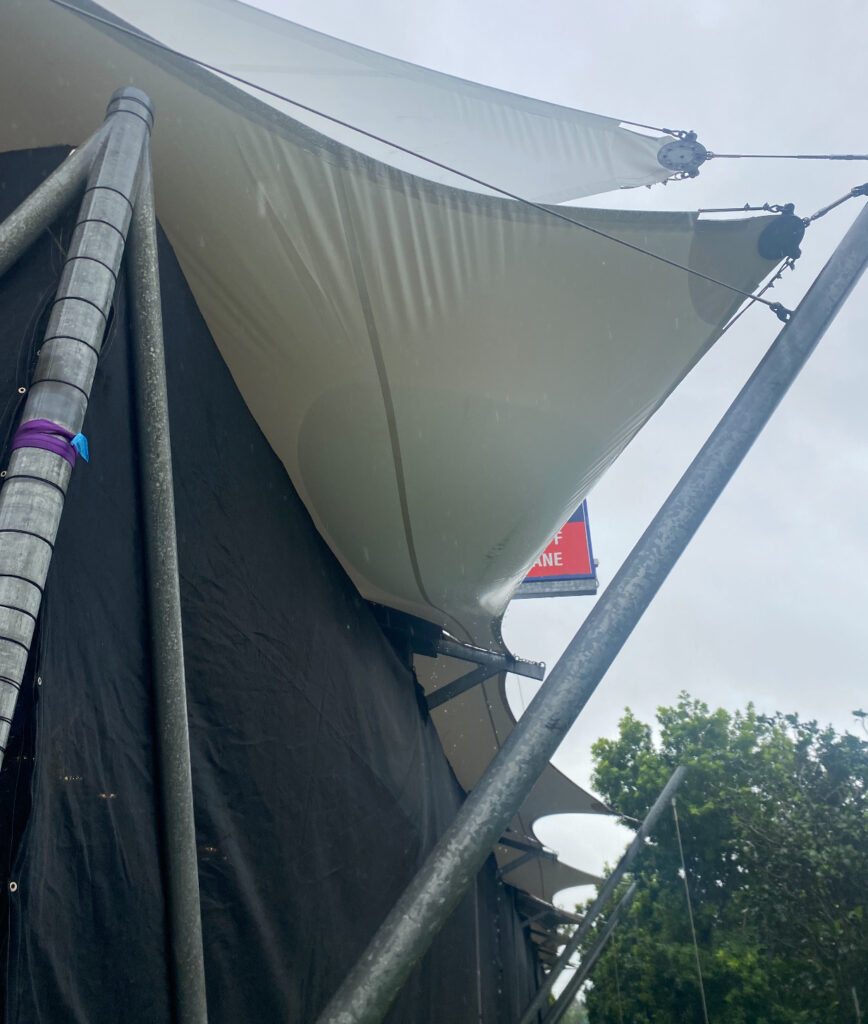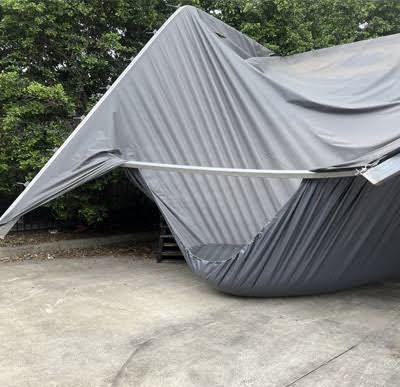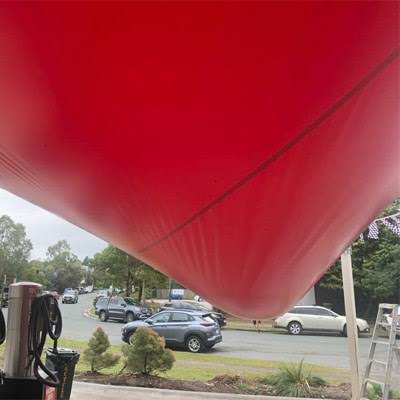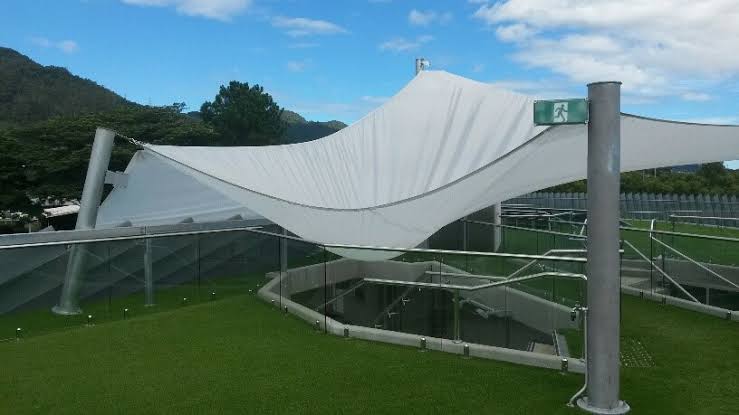Waterproof sails and awnings are a stylish and practical way to add shelter, but if they aren’t installed or maintained correctly, they can develop a frustrating problem: water ponding. This happens when rainwater collects in low points of the fabric rather than running off. Left unchecked, ponding can shorten the lifespan of your awning and even cause structural damage.
Let’s look at the main causes of ponding and the practical solutions to fix or prevent it.



Common Causes of Water Ponding
1. Insufficient Slope (Pitch)
Waterproof fabrics, such as PVC or vinyl-coated polyester, do not allow water to drain through like shade cloth does. If the awning is too flat, water has nowhere to go and pools in the middle.
- Industry rule of thumb: at least 100mm fall per metre of projection, or around 15–20°.
2. Incorrect Tension
Waterproof sails and awnings must be pulled drum-tight. If they are under-tensioned, they will sag, creating pockets where water gathers.
3. Fabric Stretch Over Time
Even strong waterproof fabrics will stretch slightly after years of exposure to sun, rain, and wind. Once stretched, the surface loses its designed slope, leading to sagging areas.
4. Frame or Fixing Issues
If brackets, posts, or arms shift or loosen over time, the geometry changes. A perfectly sloped awning can suddenly develop a low point.
5. Oversized Spans Without Support
Large sails or awnings with long unsupported spans are more likely to sag. Without a central high point or extra supports, ponding becomes inevitable.
Problems Ponding Can Cause
- Excessive weight: Water weighs about 1kg per litre. A few square metres of ponding can put hundreds of kilos of stress on your fabric and frame.
- Fabric damage: Stretching, seam separation, and tearing.
- Thread failure: Stitching often fails before the fabric itself.
- Reduced lifespan: Constant stress and water exposure shorten the awning’s service life.

Solutions to Fix or Prevent Ponding
Adjust the Pitch
- Re-mount one side of the awning higher or lower to create the proper fall.
- For sails, design with a hypar (twist) so water naturally drains to the corners.
Re-Tension the Fabric
- Use the turnbuckles or ratchets provided in the system to tighten the sail or awning.
- Re-tension regularly as part of routine maintenance.
Add Support
- Anti-ponding poles or bars can be fitted under the fabric to lift low spots.
- For large sails, consider a central mast or additional fixing point to create a peak.
Replace Stretched or Failing Fabric
- If the fabric has lost its elasticity or seams are failing, re-tensioning won’t solve the problem. Replacement with a high-quality, UV-stable waterproof fabric may be more cost-effective.
Regular Inspections
- Check for sagging or loose fixings every few months.
- Remove ponded water immediately to avoid damage.
Water ponding on waterproof sails and awnings is usually a design, installation, or maintenance issue. With the right slope, tension, and support, ponding can be completely avoided. If you’re already experiencing problems, re-tensioning or adding anti-ponding solutions may be enough. But if the fabric is stretched or the installation was poorly designed, replacing or reconfiguring may be the only long-term fix.
A well-designed waterproof awning should keep you dry for years without pooling problems—so addressing ponding early will save both headaches and costly repairs down the track.
What to Do When PVC Awning or Shade Sail Fabric Stretches After Ponding
PVC-coated fabric is a popular choice for waterproof awnings and shade sails. It’s durable, blocks rain, and offers excellent sun protection. But one weakness of PVC is that when water ponds on it, the fabric can stretch and sag permanently, leaving you with a droopy awning that no longer drains properly.
If you’ve noticed your awning fabric sagging after heavy rain, here’s what’s happening—and what you can do about it.
Why PVC Fabric Stretches After Ponding
- Water weight: A small pool of water adds a surprising amount of weight—hundreds of kilos in some cases—pulling the fabric downward.
- Material memory: PVC doesn’t have the same elasticity as woven fabrics. Once stretched, it often won’t “bounce back” to its original shape.
- Seam stress: Ponding forces seams to take more load than they were designed for, leading to thread failure and accelerated wear.
- Frame or tension issues: If the sail wasn’t installed with enough slope or tightness, ponding is more likely and stretching happens faster.
Immediate Steps if Your Awning Has Stretched
- Drain the Water Quickly
- Use a broom or pole to push the water out.
- Avoid leaving pooled water overnight.
- Re-Tension the Fabric
- Many sails and awnings use turnbuckles or ratchet systems—tighten them to pull the fabric drum-tight again.
- This may recover some of the shape, but once PVC has stretched significantly, it rarely returns to its original condition.
- Inspect for Damage
- Look closely at seams, corners, and stitching. If they are tearing or thread is breaking, re-stitching with UV-stable thread may be needed.
Long-Term Solutions
Correct the Slope (Pitch)
- A waterproof awning should have at least 100 mm of fall per metre of projection.
- For large sails, a twisted “hypar” design ensures water runs to the corners instead of sitting in the middle.
Add Anti-Ponding Supports
- Install anti-ponding poles or bars to lift low spots.
- Retractable awnings often come with optional support arms for this reason.
Replace the Fabric if Stretched Beyond Repair
- If the sail remains loose and sagging even after re-tensioning, it has likely stretched too far.
- Replacement with new, UV-stable PVC or a higher-grade membrane (like PTFE or tensile fabric) may be the most effective long-term fix.
Regular Maintenance
- Check tension seasonally.
- Clean off debris that could hold water.
- Inspect after heavy rain to ensure no pooling occurs.
Final Thoughts
Once PVC fabric has stretched due to ponding, it’s difficult—if not impossible—to fully restore it to its original shape. The best approach is prevention: correct slope, tight tension, and proper support. If stretching has already occurred, re-tensioning may help in the short term, but in many cases, replacing the fabric is the only reliable long-term solution.
By acting quickly and maintaining your awning properly, you can avoid ponding problems and enjoy a strong, waterproof shelter for years.
